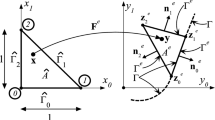We have developed software for computation of geometric characteristics and analysis of tangential stresses of prismatic bars with an arbitrary cross section in the stages of preprocessing, processing, and postprocessing of data in a finite-element analysis. Based on the principle of virtual works, we obtain variational functionals for the Saint-Venant problem of torsion of a prismatic bar and bending by a transverse force that does not cause torsion. These functionals are directly used to obtain resolving relations of the finite-element method. On the basis of the Betti reciprocal theorem, the coordinates of the center of bending are determined. We formulate all relations for the warping function, which enables us to avoid problems associated with ambiguity in the case of using the Prandtl function of stresses for a multiply connected domain.
Similar content being viewed by others
References
I. A. Birger and Ya. G. Panovko, Strength, Stability, and Vibrations [in Russian], Mashinostroenie, Moscow (1968).
V. S. Karpilovskii, E. Z. Kriksunov, A. A. Malyarenko, M. A. Mikitarenko, A. V. Perel’muter, and M. A. Perel’muter, SCAD Office. SCAD Computational Complex [in Russian], ASV, Moscow (2004).
A. I. Lur’e, Theory of Elasticity [in Russian], Nauka, Moscow (1970).
W. Nowacki, Teoria Sprężystości, PWN, Warsaw (1970).
V. V. Novozhilov, Theory of Elasticity [in Russian], Sudpromgiz, Leningrad (1958).
V. I. Slivker, Structural Mechanics. Variational Fundamentals [in Russian], ASV, Moscow (2005).
S. Timoshenko and J. N. Goodier, Theory of Elasticity, McGraw-Hill, New York (1970).
S. B. Dong, C. Alpdogan, and E. Taciroglu, “Much ado about shear correction factors in Timoshenko beam theory,” Int. J. Solids Struct., 47, No. 13, 1651–1665 (2010).
F. Gruttmann and W. Wagner, “Shear correction factors in Timoshenko’s beam theory for arbitrary shaped cross sections,” Comput. Mech., 27, No. 3, 199–207 (2001).
F. Gruttmann, R. Sauer, and W. Wagner, “Shear stresses in prismatic beams with arbitrary cross sections,” Int. J. Numer. Meth. Eng., 45, No. 7, 865–889 (1999).
O. Schenk and K. Gärtner, “Two-level dynamic scheduling in PARDISO: Improved scalability on shared memory multiprocessing systems,” Parallel Comput., 28, No. 2, 187–197 (2002).
O. C. Zienkiewicz and R. L. Taylor, The Finite-Element Method, Vol. 1: The Basis, Elsevier, Oxford (2000).
Author information
Authors and Affiliations
Additional information
Translated from Matematychni Metody ta Fizyko-Mekhanichni Polya, Vol. 55, No. 2, pp. 156–169, April–June, 2012.
Rights and permissions
About this article
Cite this article
Fialko, S.Y., Lumelskyy, D.E. On numerical realization of the problem of torsion and bending of prismatic bars of arbitrary cross section. J Math Sci 192, 664–681 (2013). https://doi.org/10.1007/s10958-013-1424-4
Received:
Published:
Issue Date:
DOI: https://doi.org/10.1007/s10958-013-1424-4




